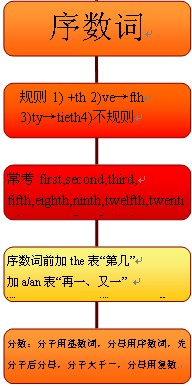本试题 “Quiet Virtue: The ConscientiousThe everyday signs of conscientiousness (认真尽责)—being punctual, careful in doing work, self-disciplined, and scru...” 主要考查您对序数词
等考点的理解。关于这些考点您可以点击下面的选项卡查看详细档案。
- 序数词
序数词的概念:
表示顺序的数称为序数词。如:first, second, third, fourth。
序数词的构成与用法:
1、序数词的构成:
①一般来说,是由相应的基数词加词尾th构成。
例:four+th→fourth
six+th→sixth
seven+th→seventh
ten+th→tenth
②下面这些基数词在变为序数词时,有特殊的变化。
例:one→first
two→second
three→third
five→fifth
eight→eighth
nine→ninth
twelve→twelfth
③十位整数序数词的构成方法是将基数词的词y变成i,然后再加eth。
例:twenty→twentieth
thirty→thirtieth
forty→fortieth
ninety→ninetieth
④两位或两位以上的基数词变成序数词时,仅将个位数变成序数词。
例:twenty-one→twenty-first
thirty-five→thirty-fifth
a hundred and fifty-three→a hundred and fifty-third
2、序数词的用法:
①序数词在使用时,一般加上定冠词。
例:the first book
the second floor
the third day
the fourth week.
②序数词在多数情况下都用作定语,有的也可以作表语、主语和宾语。
例:The may1st is Labour Day. 五月一日是劳动节。
My room is on the second floor. 我的房间在二楼。
The first is larger than the secon.(主语)第一个比第二个大。
Read the book from the first.(宾语)从开头读这本书。
You'll be the sixth to write.(表语)你将是第六个写的。
③序数词的前面可以加上不定冠词,用来表示“再一”,“又一”的意思。
例:You may have a third try. 你可以第三次尝试。
序数词知识体系:

约数的表达方法:
用tens/dozens/scores/hundreds/thousands/millions of 表示“几十、几百、上千、成千上万”等。
如:The boy bought dozens of pencils.
Thousands of people died in the earthquake.
注意: (A):dozen, score, hundred, thousand, million等表示确切数量时,不用复数。
如:five dozen (of) eggs 五打鸡蛋
hree hundred people 三百个人
分数词的构成和用法:
1)分数词构成法:
分数词(FractionalNumerals)由基数词和序数词构成,基数词代表分子,序数词代表分母。除了分子为1的情况下,序数词都要用复数形式:
如:1/4:one-fourth
5/9:five-ninths
2/3:two-thirds
17/5:three and two-fifths
7/12:seven-twelfths
379/8:forty-seven and three-eighths
此外还有下面表示法:
如:1/2:a(one) half
1/4:a(one) quarter
3/4:three-quarters
9/4:two and a quarter
3/2:one and half
31/4:seven and three quarters
与“Quiet Virtue: The ConscientiousThe everyday signs of cons...”考查相似的试题有:
- —________ you leave now? You only arrived an hour ago!—Sorry, but so much homework is waiting for me.A.MustB.MayC....
- 阅读下面短文,根据以下要求:1)括号内汉语提示;2)该词首字母提示3;)上下文语境提示,在每个空格内填入一个适当的英语单词...
- 下面短文中共有10个错误, 请找出并按要求在文中标记并改正在短文下。如多一个词:把多余的词用斜线(/)划掉。如缺一个词:...
- 短文改错(共10小题:每小题1分,满分10分)假定英语课上老师要求同桌之间交换修改作文,请你修改你同桌写的以下作文。文中共...
- Police now believe that the crime could be ________ to the one which happened last week.A.relatedB.combinedC.fixed...
- (2013·济宁一中高考模拟)—Have you got any books on English grammar?I'd like to borrow ________.—Yes,here you are.But...
- 信息匹配 阅读下列材料,从所给的六个选项(A、B、C、D、E、F)中,选出符合各小题要求的最佳选项。选项中有一项是多余选项。首...
- The couple did have a quarrel about money last night, but now they have already .A.taken upB.made upC.put upD.bro...
- After graduating from college,I took some time off to go travelling,________ turned out to be a wise decision.(2010...
- What is your favourite colour? Do you like yellow, orange or red? 小题1: Do you prefer greys and blues? Then you are ...